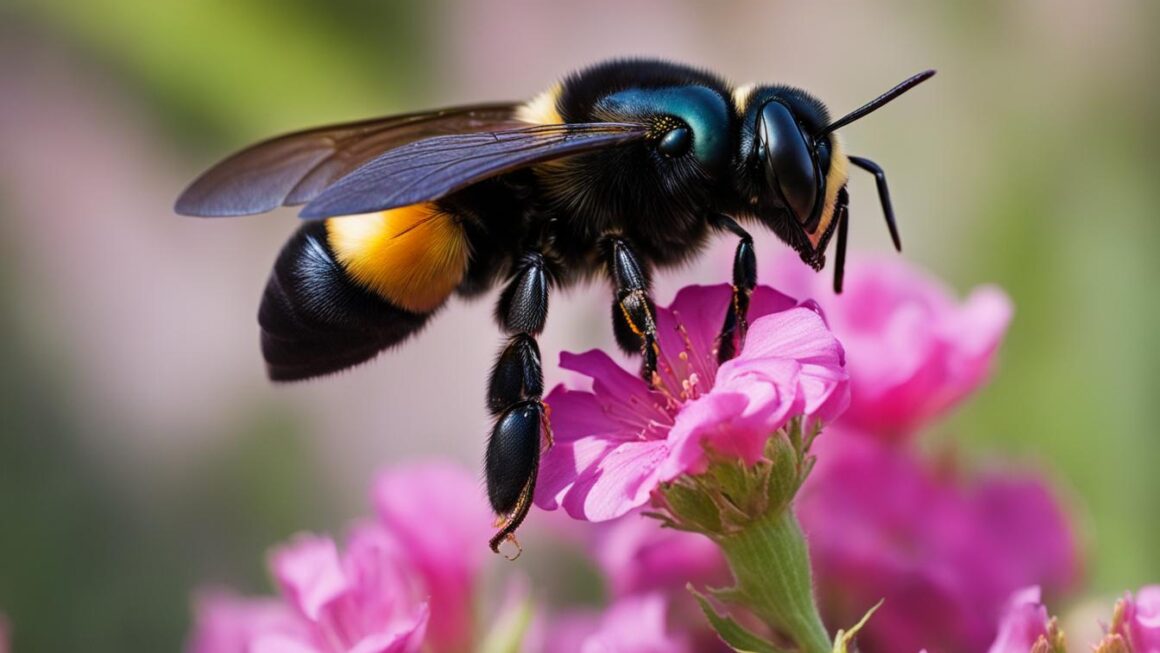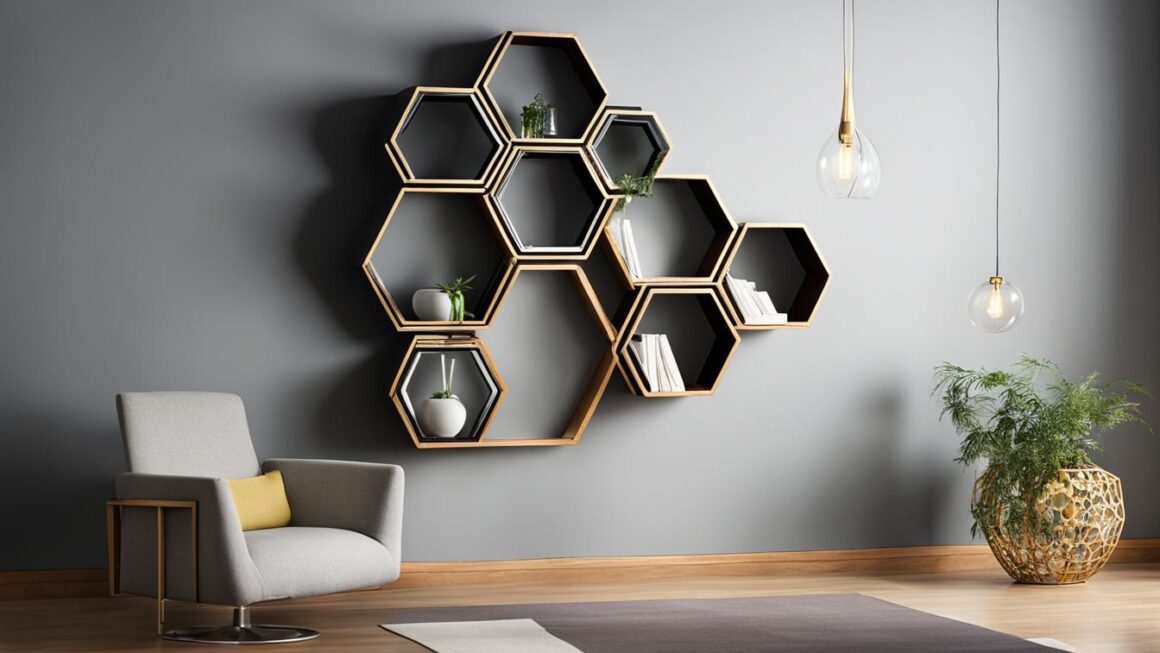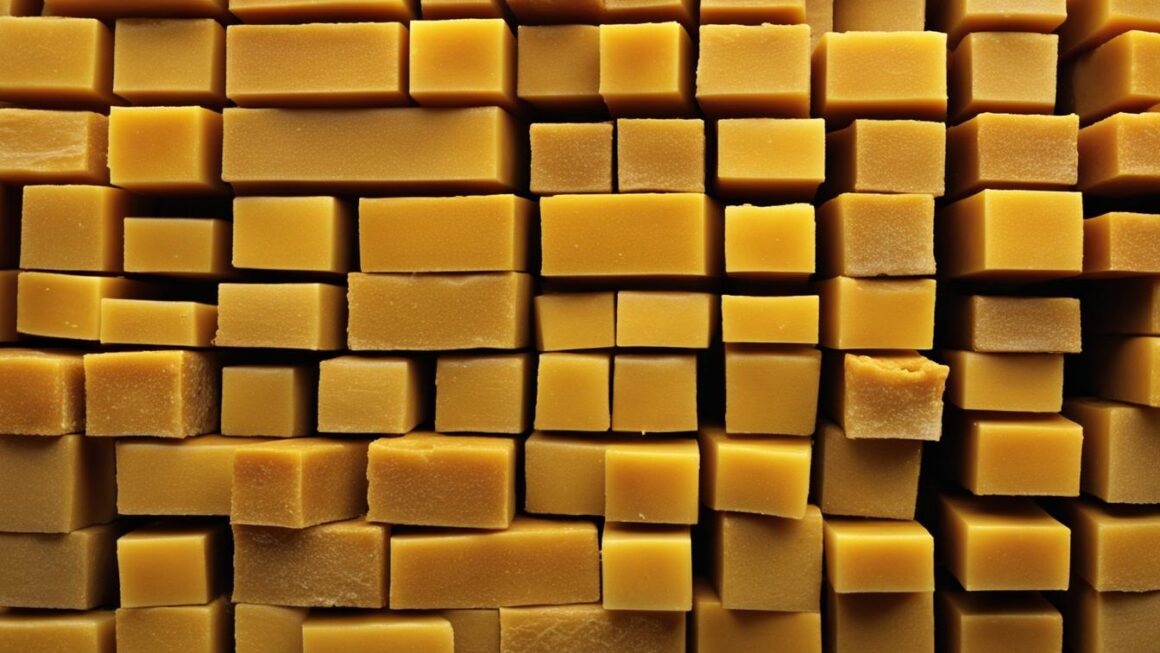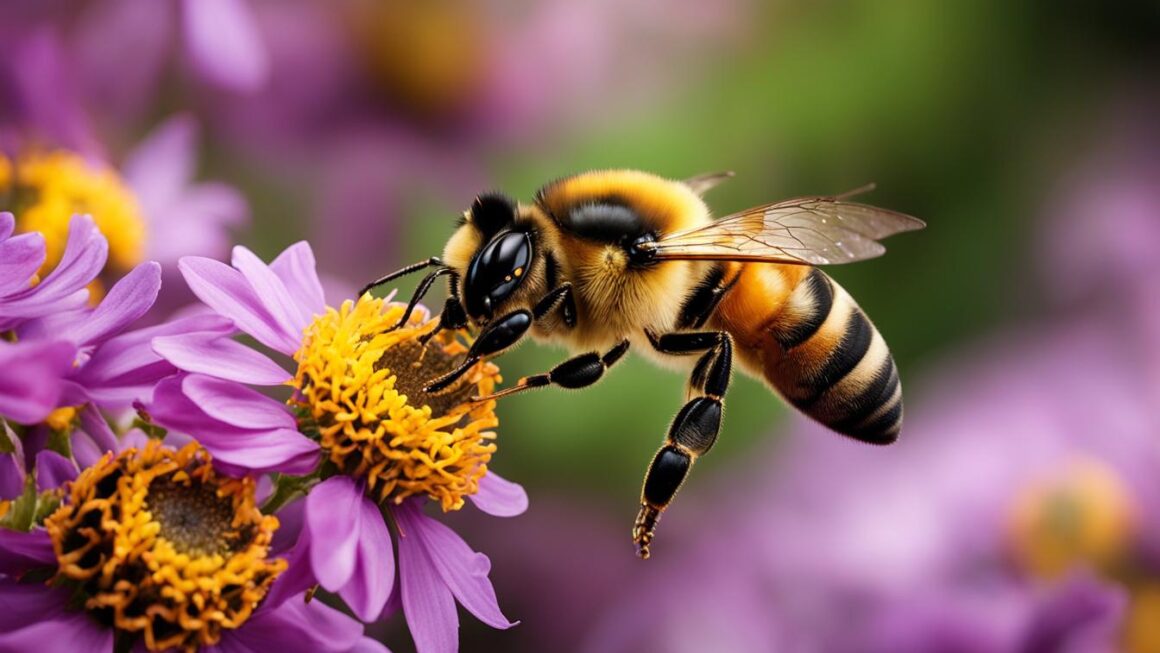Carpenter bees are fascinating creatures with unique behaviors and characteristics. While they may not produce honey like their honey bee counterparts, they play a vital role in the ecosystem as important pollinators. Let’s delve into some intriguing facts about carpenter bees and explore their behavior in more detail.
Despite their name, carpenter bees do not make honey. Unlike honey bees that live in organized colonies and work together to produce honey, carpenter bees are solitary creatures that live alone. This solitary lifestyle means that they do not have the necessary number of bees to produce honey for survival.
Key Takeaways:
- Carpenter bees do not make honey like honey bees
- They are solitary bees and live alone
- Carpenter bees play a role as important pollinators
- Unlike honey bees, carpenter bees cannot produce enough honey for survival
- The behavior of carpenter bees involves nesting in wood
The Life Cycle of Carpenter Bees
Carpenter bees, despite their name, do not create carpentry masterpieces like their human counterparts. However, they do have a fascinating life cycle that involves the creation of nests in wood. These bees are solitary creatures, meaning they live alone rather than in colonies like honey bees. Let’s take a closer look at the different stages of the carpenter bee life cycle.
Nest Building
The life cycle of a carpenter bee begins with the female bee carving a tunnel into wood to create a nesting site. This tunnel serves as a safe haven for her eggs. Carpenter bees are excellent woodworkers and can excavate perfectly round holes in various wooden structures such as trees, fences, or even the eaves of buildings. Their preferred choice of wood is usually unpainted or weathered, making decks and outdoor furniture prime targets.
Once the female carpenter bee has created the tunnel, she deposits a single egg in each brood cell. She also provides a mixture of pollen and nectar as food for the developing larvae. The female bee seals each cell with a plug of chewed wood pulp, effectively creating separate chambers for her offspring.
The Life Stages
After a few days, the eggs hatch into larvae. These larvae feed on the stored pollen and nectar, growing and developing within the safety of their wooden chambers. As they mature, they go through several larval stages before eventually spinning a cocoon and entering the pupal stage.
Inside the cocoon, the pupae undergoes metamorphosis, transforming into an adult carpenter bee. This process typically takes a few weeks to complete. When the time is right, the adult bee emerges from the cocoon and tunnels its way out of the wooden nest.
Once emerged, the adult carpenter bees are active during the warmer months, buzzing around, and seeking nectar from flowers. They are important pollinators and play a vital role in the ecosystem. As the colder months approach, adult carpenter bees will hibernate inside their nests until the following spring when they emerge again.
| Stage | Duration |
|---|---|
| Egg | 6-10 days |
| Larva | 5-7 weeks |
| Pupa | 2-4 weeks |
| Adult | Several months to a year |
Understanding the life cycle of carpenter bees can help us better manage and control their populations, while also appreciating their important role in pollination.
Carpenter Bees vs. Honey Bees
Carpenter bees and honey bees have distinct behaviors and roles in the ecosystem. While honey bees live in colonies and work together to produce honey, carpenter bees are solitary and do not produce honey. Instead, they focus on their own survival and that of their offspring.
Carpenter bees are known for their nesting behavior, which can cause damage to wooden structures. They bore into wood to create their nests, leaving behind noticeable holes. This behavior often results in concerns about structural damage. However, it’s important to note that carpenter bees cause minimal structural damage compared to other wood-boring insects. Their impact is often overstated, and proper control measures can help prevent further damage.
Despite their potential to cause structural concerns, carpenter bees are valuable pollinators in the ecosystem. They play a crucial role in the reproduction of many plant species by transferring pollen from male to female flowers. This ensures the survival and diversity of plant populations. Therefore, finding a balance between managing carpenter bee populations and preserving their role as pollinators is essential.
Carpenter Bee Behavior
Carpenter bees, like honey bees, are important pollinators. They collect nectar and pollen from flowers as a food source, inadvertently transferring pollen from one flower to another. This behavior is crucial for plant reproduction and the production of seeds and fruits.
In terms of nesting behavior, carpenter bees prefer to excavate galleries in untreated or weathered wood. They create perfectly round entrance holes, leading to tunnels that extend deep into the wood. These nests are used for shelter and raising their larvae. However, it’s worth noting that carpenter bee nests are not as extensive or damaging as termite or woodpecker damage.
Controlling carpenter bees involves a combination of prevention and management techniques. By reducing the availability of suitable nesting sites, such as sealing and painting exposed wood surfaces, the likelihood of carpenter bee activity can be reduced. Physical barriers, such as screens or specialized paint additives, can also deter carpenter bees from boring into wood.
| Comparison | Carpenter Bees | Honey Bees |
|---|---|---|
| Lifestyle | Solitary | Colonial |
| Role in Honey Production | Do not produce honey | Collectively produce honey |
| Nesting Behavior | Bore into wood to create nests | Create hives using wax combs |
| Damage Potential | Minimal structural damage | No structural damage |
| Contribution to Pollination | Important pollinators | Important pollinators |
In conclusion, while carpenter bees and honey bees have different behaviors and nesting habits, both play important roles in the ecosystem. Carpenter bees can cause minimal structural damage, but their impact is often overstated. By implementing effective control and prevention measures, it is possible to manage carpenter bee populations while still benefiting from their crucial role as pollinators.
The Importance of Carpenter Bees in Pollination
Carpenter bees, despite their reputation as wood-boring pests, play a crucial role in the pollination of various plants. Their unique behaviors and characteristics make them excellent pollinators, especially for plants that rely on buzz pollination. Understanding the importance of carpenter bees in pollination can help us appreciate their role in maintaining biodiversity and ecosystem health.
Carpenter bees are known for their ability to perform buzz pollination. This process involves the bees grabbing onto a flower’s anthers and vibrating their flight muscles, causing the release of pollen. This unique technique allows carpenter bees to effectively pollinate certain plants that have evolved to require this type of pollination.
In addition to buzz pollination, carpenter bees also visit a wide variety of flowers, transferring pollen from one flower to another as they forage for nectar. This helps ensure the successful reproduction of many plant species, contributing to the overall health and diversity of ecosystems. Without the pollination services provided by carpenter bees and other pollinators, many plants would struggle to produce seeds and fruits, leading to a decline in plant populations and negatively impacting other species that depend on these plants for food and habitat.
| Benefits of Carpenter Bees in Pollination | Carpenter Bee Behavior | Impact on Ecosystems |
|---|---|---|
| Contribute to plant reproduction | Perform buzz pollination | Maintain plant diversity |
| Increase seed production | Visit a wide variety of flowers | Provide food and habitat for other species |
| Support the growth of fruits and vegetables | Transfer pollen from flower to flower | Promote the overall health of ecosystems |
In conclusion, carpenter bees play a vital role in pollination, benefiting both plants and ecosystems. Their unique behaviors, such as buzz pollination, allow them to effectively transfer pollen and contribute to the reproduction and diversity of plant species. By understanding and appreciating the importance of carpenter bees in pollination, we can work towards preserving their habitats and ensuring their continued role as valuable pollinators.
Carpenter Bees as Unsung Heroes of Pollination
Carpenter bees, often overlooked as pollinators, play a crucial role in the pollination process. While they may not produce honey like honey bees, their contribution to plant reproduction and ecosystem health should not be underestimated. These bees have unique characteristics and behaviors that set them apart, making them important allies in maintaining the delicate balance of nature.
Unlike honey bees, which live in colonies, carpenter bees are solitary creatures. They create nests by carving tunnels in wood, where they lay their eggs and provide them with pollen and nectar for nourishment. As carpenter bees visit flowers to gather these resources, they unwittingly transfer pollen from one flower to another, facilitating plant reproduction.
What makes carpenter bees even more remarkable is their ability to pollinate in challenging weather conditions, such as strong winds or rain. Their larger size and robust flight muscles enable them to continue pollinating when smaller insects may be grounded. This resilience is vital for the survival of many plant species, as it ensures that pollination can occur even under adverse circumstances.
By recognizing the importance of carpenter bees as unsung heroes of pollination, we can take steps to protect and preserve their habitats. Implementing carpenter bee prevention measures, such as providing alternative nesting places and using non-chemical control methods, allows us to strike a balance between preventing damage to wooden structures and supporting these valuable pollinators.
| Key Points | Benefits | Summary |
|---|---|---|
| Carpenter bees are important pollinators | Support plant reproduction and ecosystem health | Carpenter bees contribute to the delicate balance of nature through pollination |
| Unique characteristics and behaviors | Resilient pollinators in challenging weather conditions | Carpenter bees are adaptable pollinators, able to continue their crucial work even in adverse weather |
| Balancing preservation and prevention | Protecting habitats while minimizing damage to wooden structures | By implementing prevention measures, we can find a balance between preserving carpenter bees and preventing structural damage |
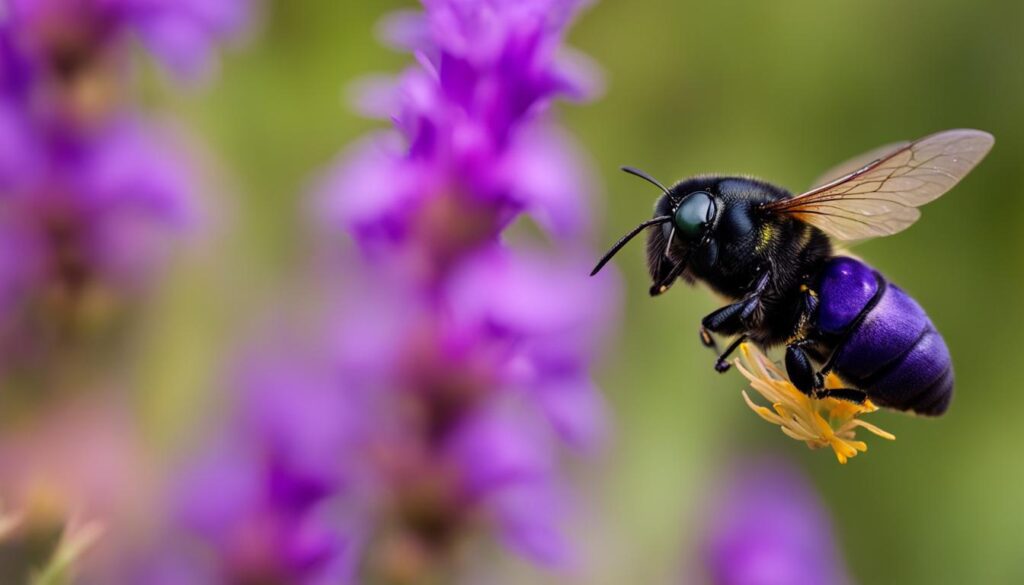
Carpenter Bees as Pests
Carpenter bees can be a nuisance and considered pests when they cause damage to wooden structures such as homes, decks, and furniture. These bees bore into the wood to create their nests, resulting in unsightly holes and potential weakening of the structures over time.
While carpenter bees cause minimal structural damage compared to other wood-boring insects like termites, their presence can still be a cause for concern. It’s important to address carpenter bee infestations to prevent further damage and preserve the integrity of wooden structures.
Table: Carpenter Bee Control Methods
| Method | Description |
|---|---|
| Wood Putty | Fill existing holes with wood putty to discourage nesting. |
| Bee Houses | Provide alternative nesting places such as bee houses to divert carpenter bees from wooden structures. |
| Chemical Treatments | Chemicals can be used to treat existing nests or create a deterrent barrier. However, caution should be exercised, considering the potential risks and environmental impacts. |
It is essential to implement effective carpenter bee control methods while also considering their role as important pollinators in the ecosystem. Striking a balance between managing carpenter bee populations and preserving their ecological contributions is crucial for maintaining a healthy environment.
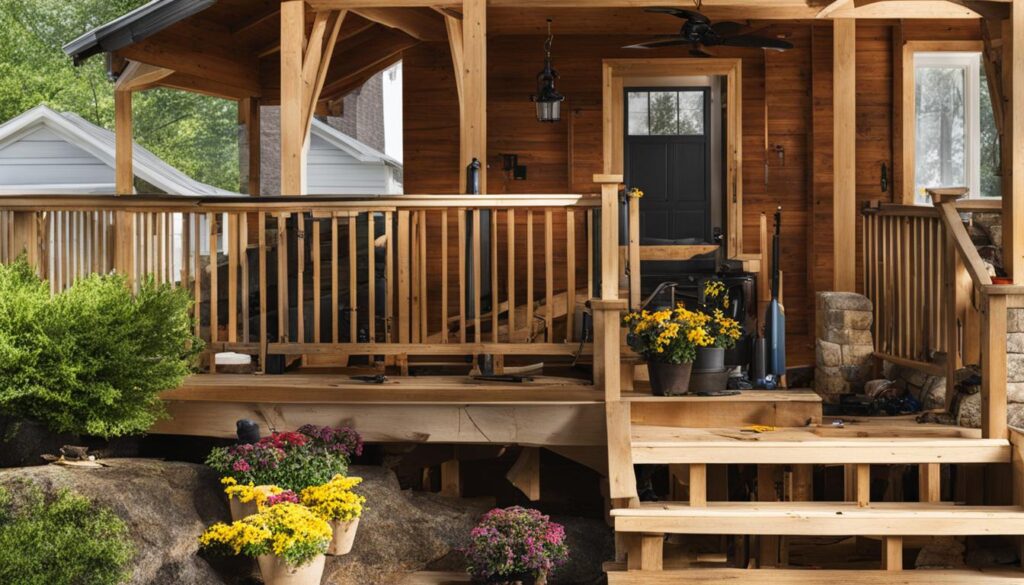
Carpenter Bees’ Impact on Humans and Ecosystems
Carpenter bees can have both positive and negative impacts on humans and ecosystems. While they may cause damage to wooden structures, they are important pollinators and play a vital role in maintaining a healthy ecosystem. It is important to find a balance between controlling carpenter bees to prevent damage and preserving their role as pollinators.
Carpenter bee prevention and control methods are necessary to minimize their impact on wooden structures. By identifying and sealing potential nesting sites, such as cracks in wood and existing holes, it is possible to deter carpenter bees from creating nests. Regular inspection and maintenance of wooden structures can also help detect early signs of carpenter bee activity and prevent further damage.
Additionally, providing alternative nesting places for carpenter bees, such as specially designed bee houses or blocks of untreated wood, can help redirect their nesting behavior away from structures that can be damaged. These alternative nesting sites can be strategically placed in gardens or near areas where carpenter bees are commonly found.
| Methods | Pros | Cons |
|---|---|---|
| Sealing potential nesting sites | – Deters carpenter bees from nesting in wooden structures – Prevents structural damage |
– Requires regular inspection and maintenance |
| Providing alternative nesting places | – Redirects carpenter bees to designated areas – Preserves wooden structures |
– Requires careful placement and monitoring |
| Chemical treatments | – Effective in eliminating carpenter bees – Offers long-term control |
– May have potential risks and environmental impacts – Should be used with caution |
It is crucial to note that while carpenter bees can cause damage to wooden structures, their impact is often minimal compared to other pests or environmental factors. By implementing preventive measures and controlling carpenter bee populations without completely eradicating them, we can strike a balance between protecting our property and preserving the important role these bees play in pollination and ecosystem health.
Carpenter Bee Control Methods
Controlling carpenter bees and preventing further damage to wooden structures can be achieved through various methods. It is important to choose the most appropriate approach based on the severity of the infestation and the desired outcome. Here are some effective carpenter bee control methods:
Non-Chemical Methods
- Wood Putty: Fill existing carpenter bee holes with wood putty to discourage nesting. This will prevent new bees from using the same holes and minimize future damage.
- Bee Houses: Providing alternative nesting places, such as bee houses, can attract carpenter bees away from wooden structures. These specially designed houses mimic natural nesting sites and can help control carpenter bee populations.
Chemical Treatments
Chemical treatments can also be used to control carpenter bees. However, caution must be exercised when using chemicals due to potential risks and environmental impacts. It is recommended to consult with a professional pest control service before applying any chemical treatments. They can provide guidance on the most effective and safe products to use.
Additionally, it is important to follow the instructions on the product label carefully and take appropriate safety precautions when handling and applying chemicals. This includes wearing protective clothing, gloves, and a mask to avoid skin contact and respiratory irritation.
| Pros of Chemical Treatments | Cons of Chemical Treatments |
|---|---|
| Effective in controlling carpenter bee populations | Potential risks and environmental impacts |
| Quick results | May require repeated applications |
| Wide range of available products | May harm beneficial insects and other wildlife |
It is important to remember that prevention is key when it comes to carpenter bee control. Regularly inspecting wooden structures, sealing any cracks or openings, and maintaining a well-painted and treated surface can help deter carpenter bees from nesting in the first place. By combining proper prevention methods with suitable control measures, it is possible to effectively manage carpenter bee infestations and protect wooden structures.
Natural Predators and Pests of Carpenter Bees
Carpenter bees, despite their ability to cause damage to wooden structures, have natural predators that help control their population. One of their primary natural predators is the woodpecker. Woodpeckers have a strong beak that they use to drill holes into the tunnels created by carpenter bees. They extract both the larvae and the adult bees, effectively reducing the number of carpenter bees in an area.
Another natural enemy of carpenter bees is the wasp parasitoid. These parasitic wasps lay their eggs inside the carpenter bee larvae or pupae. As the wasp larvae develop, they consume the carpenter bee larvae or pupae from the inside, eventually killing them. This parasitic relationship helps regulate the population of carpenter bees in nature.
It’s important to note that while these natural predators can help control carpenter bee populations, they may not completely eliminate the problem in heavily infested areas. Therefore, additional control methods may be necessary to protect wooden structures from further damage.
Table: Natural Predators of Carpenter Bees
| Predator | Description |
|---|---|
| Woodpecker | Drills holes in carpenter bee tunnels to extract larvae and adult bees, reducing population |
| Wasp Parasitoid | Lays eggs inside carpenter bee larvae or pupae, killing them from the inside |
Understanding the role of these natural predators is crucial in developing effective control strategies for carpenter bees. It’s essential to find a balance between controlling carpenter bee populations to prevent damage to wooden structures while preserving the ecological balance in the ecosystem.
The Unique Characteristics of Carpenter Bees
Carpenter bees possess distinctive characteristics that set them apart from other bee species. Understanding these unique traits can provide valuable insights into their behavior and help in implementing effective control measures.
One notable characteristic of carpenter bees is their solitary nature. Unlike honey bees that live in colonies, carpenter bees prefer to live alone. This solitary behavior means that they do not form hives or produce honey like honey bees do.
Another distinguishing feature of carpenter bees is their shiny black abdomen. This physical attribute makes them easily identifiable and distinguishes them from other bee species. Their abdomen is often mistaken for a stinger, but male carpenter bees do not have stingers and females rarely sting unless provoked.
The Importance of Understanding Carpenter Bee Behavior
Understanding carpenter bee behavior is essential for effective control and prevention. These bees are known for their nesting habits, which involve tunneling into wood to create nests for their eggs. This behavior can lead to possible damage to wooden structures, such as homes, decks, and furniture.
However, it’s important to note that the structural damage caused by carpenter bees is often minimal. While their nesting behavior may create unsightly holes and weaken wood, the actual impact on the integrity of the structure is generally overstated. Taking preventive measures and implementing control methods can help mitigate any potential damage.
Carpenter Bee Control Strategies
When it comes to controlling carpenter bees, there are various methods to consider. Non-chemical approaches include filling existing holes with wood putty to discourage nesting and providing alternative nesting options such as bee houses. These measures can help redirect carpenter bees away from structures and minimize potential damage.
Chemical treatments can also be used, but caution should be exercised due to potential risks and environmental impacts. It is crucial to follow instructions carefully and use approved products that are specifically formulated for carpenter bee control. Consulting with pest control professionals can provide additional guidance and ensure safe and effective management of carpenter bee populations.
Conclusion
In conclusion, carpenter bees, unlike honey bees, do not make honey. These solitary bees live alone and cannot produce enough honey for survival. However, carpenter bees play a vital role as pollinators in the ecosystem. Their behavior and nesting habits may cause damage to wooden structures, but it is important to note that their impact is often overstated.
Despite their reputation as pests, carpenter bees are important contributors to the pollination process. They are excellent pollinators, especially for plants that require buzz pollination. By vibrating their flight muscles, carpenter bees help dislodge pollen, supporting the reproduction of many plant species and contributing to plant diversity in ecosystems.
It is crucial to find a balance between controlling carpenter bees to prevent damage to wooden structures and preserving their role as pollinators. Various non-chemical and chemical control methods can be employed, but it is essential to use chemical treatments with caution due to potential risks and environmental impacts. Additionally, understanding the role of natural predators and pests, such as woodpeckers and wasp parasitoids, can provide insights into controlling carpenter bee infestations while maintaining the ecological balance.
FAQ
Do carpenter bees make honey?
No, carpenter bees do not make honey like honey bees. They are solitary bees and live alone, which means they cannot produce enough honey for survival.
How do carpenter bees create their nests?
Female carpenter bees carve tunnels in wood to create nests for their eggs. They deposit an egg in each brood cell and provide it with pollen and nectar for nourishment.
When do carpenter bees emerge as adults?
Carpenter bees hibernate during the colder months and emerge in late summer or early autumn.
What is the role of carpenter bees in ecosystems?
Carpenter bees are important pollinators, especially for plants that require buzz pollination. They play a crucial role in the reproduction of many plant species and contribute to plant diversity in ecosystems.
Can carpenter bees cause damage to wooden structures?
Yes, carpenter bees can cause damage to wooden structures such as homes, decks, and furniture. They bore into the wood to create their nests, which can lead to unsightly appearance and potential weakening of the structures.
How can carpenter bee infestations be controlled?
There are different methods to control carpenter bees and prevent further damage to wooden structures. Some non-chemical methods include filling holes with wood putty to discourage nesting and providing alternative nesting places such as bee houses. Chemical treatments can also be used, but they should be used with caution due to potential risks and environmental impacts.
What are the natural predators of carpenter bees?
Natural predators of carpenter bees include woodpeckers and wasp parasitoids, which help control their population.
How are carpenter bees different from other bee species?
Carpenter bees are solitary bees and do not form colonies like honey bees. They have a shiny black abdomen and are excellent pollinators in the ecosystem.
Do carpenter bees have a positive or negative impact on humans and ecosystems?
Carpenter bees have both positive and negative impacts. While they may cause damage to wooden structures, they are important pollinators and play a vital role in maintaining a healthy ecosystem. It is important to find a balance between controlling carpenter bees to prevent damage and preserving their role as pollinators.
What are some unique characteristics of carpenter bees?
Carpenter bees have unique characteristics that differentiate them from other bee species. They are solitary bees, do not live in colonies, and have a shiny black abdomen. Understanding their behavior and characteristics can help in implementing effective control measures.

